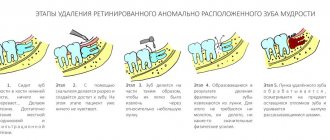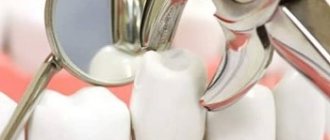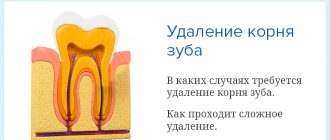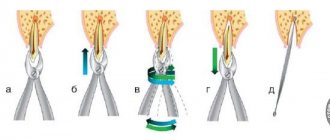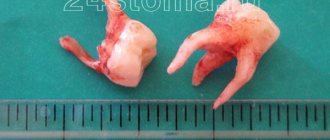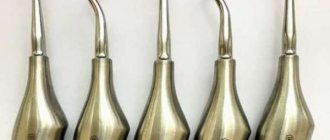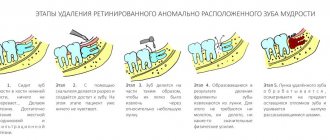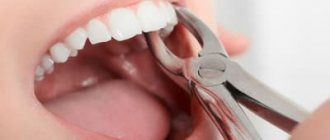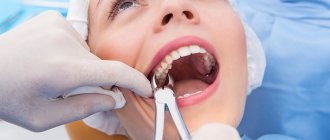Types and shapes of forceps for tooth extraction
The main surgical instruments used in dentistry are forceps. Their design differs depending on which jaw they will be used on: lower or upper.
Instruments used for the upper dentition are characterized by the fact that the axis of their cheeks and handles coincides or they are parallel. For the lower jaw, the axis of the cheeks and the axis of the handles are located either at a right angle, or this angle approaches 90 ̊.
Tooth extraction forceps also differ in other ways:
- If dental units with the crown part preserved are removed, then the design features are characterized by non-converging cheeks of the working area.
- If the roots remaining in the hole are removed, then use pliers with converging cheeks.
In order for surgery to proceed without complications, it is necessary to choose the right instrument. If the operation will be carried out in the frontal part of the upper jaw (incisors, canines), the shape of the instrument is chosen to be straight, i.e. the axes of the handles and cheeks coincide.
Forceps for removing teeth of the upper jaw of the lateral section (premolars, molars) have working parts of different sizes. To remove molars, the cheeks of the instrument are larger than for premolars. The last molars are removed using forceps with an S-shaped bend, their cheeks are located at an obtuse angle in relation to the jaws. These pliers are called bayonet pliers.
The instrumentation for removing teeth of the upper jaw has one rounded cheek and the other with a protrusion (spike). This spike is located either on the left or right side. Based on this feature, they understand which side of the dentition the instrument is intended for.
If the clinical picture is characterized by the destruction of dental tissue above the gum level, then elements with bayonet-shaped, elongated, narrowed cheeks are used to extract the root.
Dental forceps for removing teeth of the lower jaw are beak-shaped, their axes are located at right angles. Depending on which side of the dentition the pain occurs on, instruments with the appropriate cheek size are selected. The root removal tool must have converging jaws. If the dental crown is completely preserved, then the working surfaces do not converge.
In a situation where the patient has difficulty opening his mouth, removing molars from the socket becomes problematic. For the operation, horizontal nippers curved along a plane are used. They have a slightly different structure from beak-shaped forceps. Their handles and lock are located in a horizontal plane, and the cheeks bend at an angle close to 90 ̊ and are located in a vertical plane. To carry out the procedure with such instruments, movements are carried out in a horizontal plane.
Elevators
When removing a tooth using an elevator, the principle of leverage is also used. The elevator consists of:
- Working part
- Handles
- Connecting rod
All elevators are divided into straight (wide, medium, narrow - depending on the width of the working part) and angular (toward, away from you). On one side the working part is convex, on the other side there is a “groove”. During removal, the concave part (“groove”) is directed towards the root, and the convex side is directed towards the wall of the hole.
The straight elevator is used to remove the roots of single-rooted teeth or severed roots of multi-rooted teeth in both the upper and lower jaws. Angle elevators are used when removing the roots of the lower chewing teeth.
Auxiliary Tools
In severe clinical cases, when dental units are impacted or severely damaged, it is impossible to remove them using forceps. To do this, use auxiliary tools: elevator, chisel, luxator. Elevators are used in dentistry:
- W. James,
- Kuplanda,
- Cryer.
Recently, doctors have begun to replace elevators, and in some cases, dental forceps, with luxators. This choice is explained by the easy penetration of the instrument into the periodontal zone and low trauma to the alveolar bone. At the same time, the risk of postoperative complications is minimal.
Using forceps to remove teeth
Which forceps are chosen depends on:
- from the jaw on which the manipulation will be performed,
- groups of teeth (lateral, anterior),
- integrity of dental tissues,
- mouth opening width.
The type of forceps used in these cases is noted above.
The main purpose of their use is to extract the dental unit (root) from the socket. This can be done in 2 ways:
- Luxation - rocking. The method is indicated for molars and premolars with multiple roots.
- Rotation is rotation around an axis. Used to extract incisors and canines.
Operating technique using forceps:
- Local anesthesia.
- Cheek placement.
- Their advancement into the subgingival area.
- Fixation.
- Rotation or luxation.
- Extracting a dental unit from the socket.
All stages must follow strictly one after another. The success of the surgical intervention and the absence of complications depend on this.
S-shaped forceps with non-converging cheeks without spines
Premolars of the upper jaw with a preserved crown
Beak-shaped forceps, curved along a plane, with non-converging cheeks, with spines
Lower first and second molars with retained crown, with limited mouth opening
Beak-shaped forceps, curved along a plane, with non-converging cheeks, without spines
Lower third molars with a preserved crown
Complex thread type Polyfilament twisted
Monofilament yarns Polyfilament braided yarns
1. TO REMOVAL THE UPPER INCISERS AND FANGS, THE FORCEPS ARE USED: Straight
2. Conditionally absorbable is a material that: Absorbs over a longer period of time
3. TOOLS USED TO EXTRACT TEETH: Elevator, forceps
4. FRACTURE OF THE LOWER JAW IS MORE LIKELY WHEN WORKING WITH TOOLS: Lecluse elevator
5. WHEN THE ROOT OF A TOOTH IS PUSHED INTO THE POSTERIOR DEPARTMENTS OF THE HYPOGLOUS AREA DURING THE EXTRACTION OF TEETH 3.8 and 4.8, THERE ARE PERFORMED: Hospitalization of the patient
6. TO REMOVAL THE LOWER THIRD MOLAR INSTRUMENTS ARE USED: Forceps curved along a plane
7. TO REMOVAL THE FRONTAL GROUP OF TEETH OF THE UPPER JAW, THE TONGS ARE USED: Straight with non-converging cheeks
8. IN THE EVENT OF GUM RUPTURE DURING A TOOTH EXTRACTION OPERATION, IT IS SHOWN: Applying sutures to the gum
9. TO REMOVAL TEETH AND ROOTS ELEVATORS DESIGN ARE USED: Straight, Angled
10. WHEN REMOVING RIGHT PREMOLARS AND MOLARS OF THE LOWER JAW, THE DOCTOR IS FROM THE PATIENT: To the right and back
11. THE FINAL STAGE IN TOOTH ROOTS REMOVAL IS CURETAGE
12. WHEN PUSHING A ROOT INTO THE MAXILLARY SINUS, THE DOCTOR’S MISTAKEN ACTION IS: Removing the root through the hole
13. WHEN PAMPING THE socket, the iodoform turunda is removed: On days 5-7
14. IN THE AREA OF THE BOTTOM OF THE MAXILLARY SINUS THE ROOTS OF THE TEETH ARE CLOSE: Premolars and Molars
15. POSSIBLE LOCAL COMPLICATION WHEN EXTRACTING MAXILLARY TEETH: Perforation of the maxillary sinus
16. TO REMOVAL THE LOWER PREMOLARS, THE FORCEPS ARE USED: Beak-shaped without spines
17. LOCAL CAUSE OF BLEEDING FROM THE socket IS: Fracture of the intercoronal septum
18. INDICATION FOR URGENT TOOTH EXTRACTION IS: intractable purulent inflammation in the periodontium
19. WHEN EXTRACTING TEETH WITH THE CROWN PRESERVED, THE following are USED : forceps with non-converging cheeks
20. TO STOP BLEEDING WHEN SOFT TISSUE DAMAGE IS USED: Applying sutures to the wound
21. Which of the following suture materials are conditionally absorbable? Silk, polyamide
22. COMPLICATIONS ARISING DURING REMOVAL OF THE EIGHTH TOOTH OF THE UPPER JAW INCLUDE: Fracture of the tubercle of the upper jaw
23. DISLOCATION OF THE LOWER JAW IS POSSIBLE DURING TEETH EXTRACTION: 4.7, 3.7
24. MOST OFTEN, A FRACTURE OF THE LOWER JAW OCCURS DURING TEETH EXTRACTION: 3.8 4.8
25. INSTRUMENTS USED TO REMOVAL UPPER MOLARS: S-shaped forceps with a spike
26. A LOCAL COMPLICATION DURING A TOOTH EXTRACTION OPERATION IS: fracture of the crown or root of the tooth
27. A LOCAL COMPLICATION AFTER TOOTH EXTRACTION IS: Alveolitis of the socket
28. Which of the following suture materials are non-absorbable? Polyolefins, Horsehair, Metal wire
29. TO REMOVE THE ROOTS OF THE LOWER TEETH, THE FORCEPS ARE INTENDED: beak-shaped with converging cheeks
30. LOCAL LONG-TERM COMPLICATIONS AFTER TOOTH EXTRACTION INCLUDE: osteomyelitis of the socket
31. TO REMOVAL MOLARS ON THE MANDIBLE IN DIFFICULT OPENING OF THE ORAL CAVITY, THE following are used: forceps curved along a plane
32. INSTRUMENTS USED TO REMOVAL UPPER THIRD MOLARS: Special forceps
33. TO REMOVE THE ROOTS OF UPPER MOLARS THE FORCEPS ARE DESIGNED: Bayonet-shaped
34. WHEN REMOVING THE LEFT PREMOLARS AND MOLARS OF THE MANDIBLE, THE DOCTOR IS POSITIONED FROM THE PATIENT: In front and to the right
35. A COMMON CAUSE OF PROLONGED BLEEDING FROM THE socket IS: Acute leukemia
36. Synthetic suture materials include : Polyglycolic acid derivatives, polyesters
37. IF A TOOTH ROOT IS PUSHED INTO THE MAXILLIAR SINUS, YOU SHOULD: Refer the patient to the hospital
38. THE LOCAL CAUSE OF BLEEDING FROM THE DEPTH OF THE socket IS: injury to the inferior alveolar artery
39. ROTATION IS PERFORMED WHEN REMOVAL: Maxillary incisors
40. WHEN REMOVING THE SIXTH TOOTH OF THE LOWER JAW, THE FIRST MOVEMENT IS PERFORMED: Luxation to the buccal side
41. TO REMOVAL THE ROOTS OF UPPER PREMOLARS, CHEEK TONGS ARE DESIGNED: S-shaped with converging
42. TO REMOVAL THE LOWER INCISERS AND FANGS, THE INSTRUMENTS ARE USED: Beak-shaped forceps
43. IN THE FIRST VISIT FOR ALVEOLITIS, YOU SHOULD CARRY OUT: Removal of the disintegrated clot and loose introduction of iodoform turunda into the socket
44. Natural organic suture materials include: Catgut, Silk, Cellulose derivatives
45. A SIGN OF OPENING OF THE BOTTOM OF THE MAXILLARY SINUS IS: Positive oronasal test
46. TO REMOVAL DISCONNECTED TOOTH ROOTS 3.7 USED: Angle elevator
47. WHEN OPENING THE BOTTOM OF THE MAXILLARY SINUS THEY PERFORM: Suturing with a flap
48. TO REMOVAL THE LOWER THIRD MOLAR INSTRUMENTS ARE USED: Forceps curved along a plane
49. MOST OFTEN, TEETH DISPLACEMENT INTO THE THICKNESS OF SOFT TISSUE OCCURS WHEN TEETH EXTRACTION: 3.8, 4.8
50. COMPLICATIONS ARISING DURING TOOTH EXTRACTION OPERATION INCLUDE: Luxation of an adjacent tooth, Socket Bleeding
51. THE FIRST MOVEMENT WHEN REMOVAL OF THE SIXTH TOOTH OF THE UPPER JAW IS: Luxation to the palatal side
52. A COMMON CAUSE OF BLEEDING AFTER TOOTH EXTRACTION IS: Hemophilia
53. Which of the following suture materials are absorbable? Catgut, Polyurethane
54. TO STOP BLEEDING FROM THE WALLS OF THE socket, the following is done: compression of the bleeding area of the bone
55. TO REMOVAL THE LOWER MOLARS, THE FORCEPS ARE USED: Beak-shaped with spikes
56. TO TREAT THE HOLE AFTER TOOTH EXTRACTION, USE: A curettage spoon
57. DURING THE OPERATION OF ROOTS REMOVAL OF THE CENTRAL INCISORS OF THE UPPER JAW, THE following are USED: straight forceps with converging cheeks
58. TO REMOVAL THE RIGHT UPPER MOLAR WITH THE CROWN PRESERVED, THE FORCEPS ARE INTENDED: S-shaped with a spike on the left
59. BREAKING OF THE TUBE OF THE UPPER JAW CAN OCCUR WHEN TEETH EXTRACTION: 1.8, 2.8
60. IN THE EVENT OF BLEEDING FROM THE BOTTOM OF THE socket, the following should be carried out: tight tamponade of the socket with iodoform turunda
61. IN THE EVENT OF A ROOT FRACTURE, THE DOCTOR’S INCORRECT ACTION IS: leaving the root fragment in the socket
62. WHEN REMOVING THE EIGHTH TOOTH ON THE LOWER JAW, IT IS RECOMMENDED TO USE A BAYONET ELEVATOR IN THE FOLLOWING CONDITION OF THE DENTH ARCH: presence of stable 6th and 7th teeth
63. AFTER COMPLEX TOOTH EXTRACTION 4.8 SHOULD BE PRESCRIBED TO THE PATIENT: cold on the area of the angle of the lower jaw
64. THE WAY TO STOP BLEEDING FROM THE DEPTH OF THE socket IS: tight tamponade of the socket
65. MOST OFTEN A FRACTURE OF THE LOWER JAW OCCURS DURING TEETH EXTRACTION: 3.8 or 4.8
66. Natural inorganic suture materials include: Metal wire
67. BEFORE THE OPERATION OF TOOTH REMOVAL WITH FORCES, THE SURGEON PERFORMS: separation
68. MOST OFTEN, A FRACTURE OF THE LOWER JAW OCCURS DURING TEETH EXTRACTION: 3.8 4.8
69. WHEN OPENING THE BOTTOM OF THE MAXILLARY SINUS, YOU SHOULD CARRY OUT: Covering the mouth of the socket with iodoform turunda for a period of 5-7 days
70. INDICATIONS FOR ROUTINE TOOTH EXTRACTION IS: Tooth mobility of the 3rd degree
71. PERFORATION OF THE BOTTOM OF THE MAXILLARY SINUS IS MOST LIKELY WHEN TEETH EXTRACTION: 1.6, 2.6, 1.7, 2.7
72. TO REMOVAL THE UPPER PREMOLARS, THE FORCEPS ARE USED: S-shaped without a spike
73. WHEN REMOVAL OF THE SECOND MOLAR OF THE MANDIBLE, THE FIRST MOVEMENT IS PERFORMED: Luxation and rotation
74. LOCAL CAUSE OF BLEEDING AFTER TOOTH EXTRACTION IS: Soft tissue injury
SECTION: PERIODONTOLOGY
Name the instrument – Periodontal probe
Name the tool - Hoe
Name the instrument – Curette (Universal)
Name the tool - Scaler
Name the instrument – Curette (Zone-specific)
Tool holding methods
The operation is performed with the right hand. The dentist holds the instrument so that it is comfortable. There are 2 ways:
- Hold the handles of the tool with your right hand, using the 1st, 2nd and 3rd fingers. The 4th and 5th fingers of the hand are located between the branches. If the need arises, these fingers are included in the extension of the handles. As soon as the forceps close, the 4th and 5th fingers are removed from the space between the handles of the instrument.
- One handle is held with the thumb of the right hand, and the other with 4 and 5. This method is more suitable for the upper dentition. The tips of the handles of surgical instruments rest against the palm. The handles move apart, which leads to the straightening of the 3rd finger. The closure of the handles is carried out by bending the 4th and 5th fingers. After applying the cheeks to the causative tooth, the index finger is withdrawn, and the jaws are compressed with the rest of the palm.
Bayonet forceps
Bayonet-shaped forceps are divided into narrow, wide, and medium based on the width of the cheeks. These forceps are used to remove the teeth of the upper jaw, namely:
• teeth destroyed by crowns
• roots of teeth.
To remove the upper eighth teeth, forceps similar to bayonet-shaped ones are used, but the main feature is the presence of non-closing cheeks located below.
For the lower jaw, beak-shaped forceps are used. They have cheeks perpendicular to the axes of the handles. These forceps are universal - they are used to remove all teeth of the lower jaw, including their roots. To remove lower molars, forceps curved along a plane are used.
Removing teeth using an elevator
An elevator is usually used when the coronal part is severely damaged. To do this, take the handle of the tool in the palm of your right hand, place your index finger on the working part of the elevator, 1 cm away from the cheek. The cheek is deepened into the gap between the tooth being removed and the adjacent tooth in order to disrupt the ligamentous apparatus that holds the root in the socket, and a strong dislocation movement is performed.
After this, the cause of the pain is removed from the socket, sometimes requiring forceps. During operation, the cheek of the elevator rests against a nearby tooth. To prevent dislocation of this unit, it is necessary to firmly fix it in the socket with two fingers.
Using Luxators
Thanks to the luxator, it is possible to remove an impacted or severely damaged tooth with minimal stress for the doctor and the patient. The procedure is easier than using an elevator and safer.
The handle of the tool is held with the right hand. The index finger is placed slightly above the cheek of the instrument. The working part under the gum is not inserted directly, but at a slight angle. The movements are of an oscillatory (swinging) nature, disintegrating. This helps to separate the periodontal fibers, expand the alveoli and eliminate the vacuum in this area. All this contributes to the trouble-free removal of the tooth from the socket using forceps, and if it has only one root, forceps are not needed at all.
Modern dentistry has everything necessary to carry out the removal procedure efficiently and painlessly for any degree of destruction, even if only a small part of the root remains. There is no need to be afraid of surgery. Clinical observations and patient reviews show that with correctly selected instruments and highly qualified physicians, postoperative complications are reduced to zero.
Author: Natalya Stagurskaya, dentist, especially for Karies.pro
Drill
Sawing teeth using a drill is an alternative to chiseling and hammering out teeth. Both straight and turbine handpieces are used.
A straight tip (ball-shaped bur) is used to remove bone tissue that is overhanging or interfering with tooth extraction. A turbine tip (fissure burs) is most often used for sawing a tooth into several parts: separating the crown from the roots, separating the roots in order to remove them later separately.
It is necessary to remind you that when operating the drill, you must use water cooling.
We advise you to read: Tactics regarding primary teeth in adult patients
